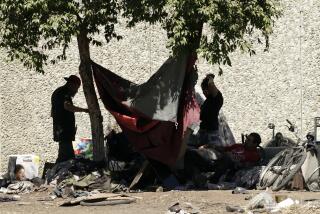Census Counts USC as a Virtual Ghost Town
- Share via
To the naked eye, the students clustered on USC’s sun-dappled campus seem incontrovertibly real.
Yet about 2,500 of them have evaporated from the 2000 census, cast into a statistical limbo puzzling to demographers and irksome to city officials intent on boosting Los Angeles’ head count.
Theirs is far from the only mysterious blank spot in what census officials have trumpeted as the most accurate tally of Americans ever.
According to the initial data released last month, Florida’s Miccosukee Indian population improbably sank from 94 to zero on the tribe’s reservation west of Miami, which added a popular casino. And tiny Chester, Ill., best known for its huge Popeye statue, lost more than one-third of its population when prisoners at the Menard Correctional Center disappeared from the town’s count.
Most of those missing people ultimately turn out to be misplaced, not uncounted. Chester’s felons, for example, were apparently lumped into neighboring Baldwin.
But so far, census, city and campus officials are still sorting through explanations for why the population in USC’s main census tract dropped from 2,750 in 1990 to 246 in 2000.
“Maybe they went into the same dimension as lost socks and pen tops,” history professor Philip Ethington said, laughing.
The notion of USC as demographic ghost town both amused and alarmed the university’s resident demographers.
Such mistakes can have serious consequences. Census figures provide the basis for redrawing voting districts and dictate how the federal government divvies up dollars to states, cities and counties.
Other communities that suspect chunks of themselves were sucked into census dead zones say they face significant cutbacks if their results stand.
“It’s pretty devastating,” said Lew Markley, a councilman in Worland, Wyo., which could lose $150,000 from its $3-million operating budget because census enumerators allocated several of its subdivisions to other places. “It just can’t be right. When I ran for election, I knocked on every door in town.”
The first step in unraveling the USC mystery will be determining whether students fell victim to correctable geographical coding glitches in the census’ system of tracts and block groups. If so, the city can challenge the error through the Census Bureau’s Count Question Resolution Program, which begins in June.
But if the students simply were not counted, the census may prove to be an exam for which there is no makeup.
As a snapshot frozen forever in April 2000, the 10-year tally does not allow for recounts. The Census Bureau has estimated based of field surveys that the 2000 tally had a net undercount of about 3.3 million Americans, including 529,782 Californians. However, the agency last month refused to endorse an adjusted set of figures that use sampling to factor in those missed.
Several cities--including Los Angeles--have mounted a lawsuit to force the Census Bureau to make public the adjusted figures, but that would not affect the distribution of federal funds.
Assistant City Atty. Jessica Heinz toured the USC campus Tuesday, eyeing in disbelief the massive Fluor, Webb, Birnkant and Marks towers and the census data that declared them empty. University records indicate that about 2,500 students lived on campus a year ago and that the dorms had an occupancy rate then of about 95%.
Census officials suspect the students may be rediscovered in several tracts around USC that experienced significant population growth. About 200 Parkside Apartments residents have turned up already, assigned wrongly to an office building across the street from the campus.
“It looks like we have a problem there and, if that’s the case, we’ll fix it,” said Steve Alnwick, assistant regional census manager for Southern California.
Still, USC geography professor Chris Williamson, who has written a book on the census process and was among the first to notice that the university’s numbers were off, wondered if bad mapping would be enough to account for the discrepancy.
“The next question is, what other errors are out there?” he said. “Of all places to find one, here’s one right in my own home. If for some reason they didn’t get counted, it’s so embarrassing.”
As the experts sift for clues, perhaps USC’s students will bond with almost 5,000 of their counterparts at the University of Virginia who are missing from unincorporated Albemarle County.
And it could be worse. In an earlier count, census lore has it, several dorms of U.S. collegians were statistically reallocated into a nearby zoo.
More to Read
Sign up for Essential California
The most important California stories and recommendations in your inbox every morning.
You may occasionally receive promotional content from the Los Angeles Times.










